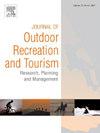Enhancing outdoor recreational experience: A methodology for assessing peri-urban greenway suitability based on hiker physical activity levels and motivations
IF 3.6
3区 管理学
Q1 HOSPITALITY, LEISURE, SPORT & TOURISM
Journal of Outdoor Recreation and Tourism-Research Planning and Management
Pub Date : 2025-05-12
DOI:10.1016/j.jort.2025.100893
引用次数: 0
Abstract
This study presents an innovative methodology for assessing greenway suitability by integrating hiker profiles. The main objectives of the study are to design a method for calculating greenway suitability for different hiking profiles, based on physical activity levels and motivations, and to carry out a proof of concept on an official greenway. Applied to the 34 km Green Ring greenway in Tarragona, Spain, the approach categorises hikers into nine hypothetical profiles combining three activity levels (inactive, active, very active) and three motivations (nature appreciation, cultural heritage, physical activity). Using Geographic Information Systems (GIS) and fieldwork, the greenway was analysed through four key indicators (comfort, difficulty, naturalness, and culturalness) which were normalised into a unified scale. The Potential Suitability Value (PSV) metric was developed to measure greenway compatibility with different hiker profiles through custom algorithms prioritising profile-relevant indicators. Results highlighted marked variability in suitability, with the greenway being most favourable for inactive hikers motivated by nature, while those seeking physical challenges found lower compatibility due to limited greenway difficulty. The methodology demonstrates scalability, offering a framework for sustainable greenway management, personalised recommendations, and enhanced user satisfaction. Overall, the study bridges recreation and sustainable land management, promoting enhanced trail and greenway experiences, fostering better health outcomes, and encouraging deeper engagement with greenways.
增强户外娱乐体验:一种基于徒步旅行者身体活动水平和动机的城郊绿道适宜性评估方法
本研究提出了一种创新的方法,通过整合徒步旅行者的资料来评估绿道的适用性。本研究的主要目的是设计一种方法,根据身体活动水平和动机,计算不同徒步旅行剖面的绿道适用性,并在官方绿道上进行概念验证。该方法应用于西班牙塔拉戈纳34公里的绿环绿道,将徒步旅行者分为九种假设的概况,结合三种活动水平(不活动、活跃、非常活跃)和三种动机(自然欣赏、文化遗产、体育活动)。利用地理信息系统(GIS)和实地调查,通过四个关键指标(舒适度、难度、自然性和文化性)对绿道进行了分析,并将其归一化为统一的尺度。开发了潜在适宜性值(PSV)指标,通过自定义算法优先考虑与剖面相关的指标,衡量绿道与不同徒步旅行者剖面的兼容性。结果强调了适应性的显著差异,绿道最适合不活跃的徒步旅行者,而那些寻求身体挑战的人由于绿道难度有限而发现兼容性较低。该方法展示了可扩展性,为可持续绿道管理、个性化建议和提高用户满意度提供了框架。总体而言,该研究将休闲和可持续土地管理联系起来,促进步道和绿道体验的增强,促进更好的健康结果,并鼓励更深入地参与绿道。
本文章由计算机程序翻译,如有差异,请以英文原文为准。
求助全文
约1分钟内获得全文
求助全文
来源期刊

Journal of Outdoor Recreation and Tourism-Research Planning and Management
HOSPITALITY, LEISURE, SPORT & TOURISM-
CiteScore
6.70
自引率
5.30%
发文量
84
期刊介绍:
Journal of Outdoor Recreation and Tourism offers a dedicated outlet for research relevant to social sciences and natural resources. The journal publishes peer reviewed original research on all aspects of outdoor recreation planning and management, covering the entire spectrum of settings from wilderness to urban outdoor recreation opportunities. It also focuses on new products and findings in nature based tourism and park management. JORT is an interdisciplinary and transdisciplinary journal, articles may focus on any aspect of theory, method, or concept of outdoor recreation research, planning or management, and interdisciplinary work is especially welcome, and may be of a theoretical and/or a case study nature. Depending on the topic of investigation, articles may be positioned within one academic discipline, or draw from several disciplines in an integrative manner, with overarching relevance to social sciences and natural resources. JORT is international in scope and attracts scholars from all reaches of the world to facilitate the exchange of ideas. As such, the journal enhances understanding of scientific knowledge, empirical results, and practitioners'' needs. Therefore in JORT each article is accompanied by an executive summary, written by the editors or authors, highlighting the planning and management relevant aspects of the article.
 求助内容:
求助内容: 应助结果提醒方式:
应助结果提醒方式:


